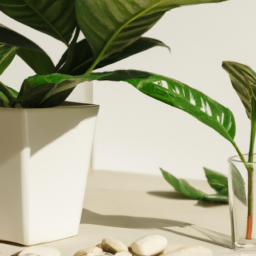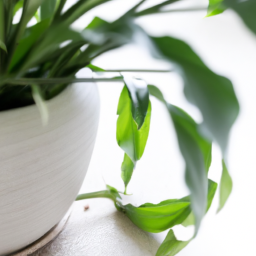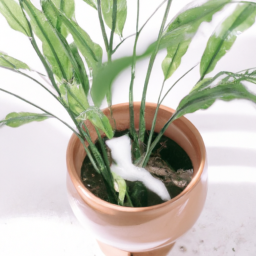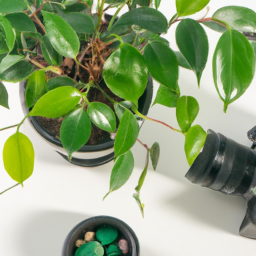
Have you ever wondered about the difference between indoor plants and outdoor plants? Whether you’re a seasoned plant enthusiast or just starting to dabble in gardening, understanding the distinctions between these two types of plants can help you better care for them and ensure they thrive in their environment. In this blog post, we’ll explore the key differences between indoor plants and outdoor plants, from their unique needs to the benefits they bring to your home or garden. So grab your favorite mug of tea and let’s dive into the world of indoor and outdoor plants!
Benefits of Indoor Plants vs. Outdoor Plants
Indoor Plants
Indoor plants have become increasingly popular in recent years, as more people are recognizing the numerous benefits they provide. One of the main advantages of indoor plants is their ability to improve air quality. Plants naturally absorb carbon dioxide and release oxygen through the process of photosynthesis, which can help to purify the air in your home or office. This can lead to a healthier indoor environment and can even help to reduce symptoms of respiratory conditions such as asthma.
In addition to improving air quality, indoor plants can also help to reduce stress and improve overall well-being. Studies have shown that simply being around plants can have a calming effect on people, leading to lower levels of anxiety and improved mood. This can be especially beneficial in today’s fast-paced, technology-driven world, where many people are constantly exposed to high levels of stress.
Another benefit of indoor plants is their ability to enhance the aesthetic appeal of a space. Plants can add a pop of color, texture, and life to any room, making it feel more inviting and cozy. They can also serve as natural decorations, helping to create a more relaxing and harmonious atmosphere. Whether you prefer small succulents or large leafy plants, there are endless options to choose from to suit your personal style and preferences.
Outdoor Plants
While indoor plants have their own set of benefits, outdoor plants also offer a range of advantages that are worth considering. One of the main benefits of outdoor plants is their ability to thrive in natural sunlight and fresh air. Outdoor plants have access to natural elements that indoor plants may lack, such as rainwater and beneficial insects, which can help to promote healthy growth and resilience.
In addition to the benefits of natural sunlight and fresh air, outdoor plants also have the potential to attract wildlife, such as birds and butterflies, to your garden. This can create a more vibrant and dynamic outdoor space, adding to the overall beauty and biodiversity of your yard or garden. Watching birds feed on nectar from flowers or butterflies fluttering from plant to plant can be a rewarding and enjoyable experience for nature lovers.
Another advantage of outdoor plants is their ability to provide food and shelter for beneficial insects, such as bees and ladybugs, which can help to pollinate flowers and control pests in your garden. By creating a diverse and healthy ecosystem in your outdoor space, you can reduce the need for harmful pesticides and chemicals, while promoting a more sustainable and eco-friendly approach to gardening.

Care Tips for Indoor Plants and Outdoor Plants
Indoor Plants
Indoor plants are a great way to bring nature into your home and add a touch of greenery to your living space. However, caring for indoor plants requires a bit of knowledge and attention to ensure they thrive in their indoor environment. Here are some care tips for indoor plants:
1. Light: Indoor plants require different levels of light depending on the type of plant. Some plants thrive in bright, indirect light, while others prefer low light conditions. Make sure to place your indoor plants in a location that receives the appropriate amount of light for their specific needs.
2. Watering: Overwatering is a common mistake when caring for indoor plants. It is important to water your plants according to their individual needs. Some plants prefer to dry out between waterings, while others like to stay consistently moist. Be sure to check the soil moisture before watering to avoid overwatering.
3. Humidity: Indoor plants can benefit from increased humidity, especially during the winter months when indoor heating can dry out the air. You can increase humidity by misting your plants with water, placing a humidifier nearby, or grouping plants together to create a microclimate of higher humidity.
Outdoor Plants
Outdoor plants have the advantage of natural sunlight, fresh air, and access to rainwater, but they still require proper care to thrive in your garden or yard. Here are some care tips for outdoor plants:
1. Soil: Good soil is essential for the health of outdoor plants. Make sure to use a well-draining soil that is rich in nutrients to provide a good foundation for your plants to grow. You can also add compost or other organic matter to improve soil quality.
2. Watering: Outdoor plants may require more frequent watering, especially during hot, dry weather. It is important to water deeply to encourage deep root growth and avoid shallow roots. Water in the early morning or late evening to reduce evaporation loss.
3. Pruning: Regular pruning is important for outdoor plants to promote healthy growth and flowering. Remove dead or diseased branches, shape the plant for better aesthetics, and encourage new growth. Be sure to use clean, sharp pruning tools to avoid damaging the plant.
By following these care tips for indoor and outdoor plants, you can ensure that your plants thrive and bring beauty to your home and garden. Remember to observe your plants regularly and adjust your care routine as needed to keep them healthy and happy.

Factors to Consider When Choosing Between Indoor and Outdoor Plants
Light Requirements
When deciding between indoor and outdoor plants, one of the most important factors to consider is the light requirements of the plant. Indoor plants typically require less light than outdoor plants, as they are shielded from direct sunlight. However, some indoor plants, such as succulents and cacti, thrive in bright, indirect light. On the other hand, outdoor plants need ample sunlight to photosynthesize and grow properly. Before choosing a plant, consider the amount of natural light available in your home or garden.
In addition to natural light, you can also supplement indoor plants with artificial light sources, such as grow lights. These lights mimic the spectrum of natural sunlight and can help indoor plants thrive in low-light conditions. Outdoor plants, on the other hand, rely solely on natural sunlight for their growth. When choosing between indoor and outdoor plants, be sure to consider the light requirements of the plant and whether you can provide the necessary light conditions for its growth.
Another important factor to consider when choosing between indoor and outdoor plants is the temperature requirements of the plant. Indoor plants are typically more sensitive to temperature fluctuations than outdoor plants, as they are shielded from the elements. Most indoor plants prefer temperatures between 65-75 degrees Fahrenheit during the day and slightly cooler temperatures at night.
Outdoor plants, on the other hand, are more resilient to temperature fluctuations and can tolerate a wider range of temperatures. Before choosing a plant, be sure to research its temperature requirements and consider whether you can provide the necessary conditions for its growth. Additionally, consider the climate in your area and whether it is suitable for the plant you have in mind.
Humidity Levels
Another factor to consider when choosing between indoor and outdoor plants is the humidity levels in your home or garden. Indoor plants typically require higher humidity levels than outdoor plants, as they are often exposed to dry indoor air. To increase humidity levels for indoor plants, you can mist them regularly, place a humidifier nearby, or group them together to create a microclimate.
Outdoor plants, on the other hand, are exposed to natural humidity levels and do not require additional humidity. Before choosing a plant, consider the humidity levels in your home or garden and whether you can provide the necessary conditions for its growth. Some plants, such as ferns and orchids, thrive in high humidity environments, while others, such as succulents and cacti, prefer low humidity levels.
In addition to humidity levels, you should also consider the watering requirements of the plant when choosing between indoor and outdoor plants. Indoor plants typically require more frequent watering than outdoor plants, as they are often exposed to dry indoor air. To prevent overwatering, be sure to allow the soil to dry out between waterings and use a well-draining potting mix.
Outdoor plants, on the other hand, rely on natural rainfall for their watering needs and do not require as frequent watering. Before choosing a plant, be sure to research its watering requirements and consider whether you can provide the necessary conditions for its growth. Additionally, consider the type of soil in your garden and whether it drains well to prevent waterlogged roots.
Let’s recap
Indoor plants and outdoor plants may seem similar at first glance, but there are actually several key differences between the two. One major distinction is the amount of sunlight they receive. Indoor plants typically require less sunlight than outdoor plants, as they are shielded from the harsh rays of the sun by the walls of a building. This means that indoor plants are often better suited for low-light environments, such as offices or bathrooms.
Another important difference is the amount of water that indoor and outdoor plants need. Because indoor plants are not exposed to the elements, they tend to retain moisture better than outdoor plants. This means that indoor plants generally require less frequent watering than outdoor plants, which can be a major advantage for busy plant owners. Additionally, indoor plants are less susceptible to pests and diseases that are commonly found in outdoor environments, making them a great option for those looking for low-maintenance greenery in their homes.
Your Questions Answered. Comprehensive FAQ:
Q1. What is the main difference between indoor plants and outdoor plants?
Indoor plants are specifically suited to thrive in the conditions found inside a home or office, while outdoor plants are designed to withstand the elements of the outdoors.
Q2. Can indoor plants be placed outside and vice versa?
While some indoor plants can tolerate being placed outside temporarily, most indoor plants are not equipped to survive the harsh conditions of the outdoors long-term. Outdoor plants, on the other hand, may struggle to thrive indoors due to lack of sunlight and proper ventilation.
Q3. Do indoor plants require different care than outdoor plants?
Yes, indoor plants typically require more frequent watering and attention to humidity levels since they are not exposed to natural elements like rain and sunlight. Outdoor plants may require less maintenance as they can rely on natural sunlight and rainwater.
Q4. Can outdoor plants be brought indoors during colder months?
Some outdoor plants can be brought indoors during colder months to protect them from frost or extreme temperatures. However, it’s important to acclimate the plants slowly to the indoor environment to prevent shock.
Q5. Are there any benefits to having both indoor and outdoor plants?
Having a mix of indoor and outdoor plants can provide a variety of benefits. Indoor plants can help improve air quality and add a touch of nature to indoor spaces, while outdoor plants can enhance the curb appeal of your home and create a welcoming outdoor environment.
Dr. Olivia Green is a botanist with over two decades of experience in indoor plant cultivation. She holds a Ph.D. in Plant Biology and has dedicated her career to researching plant behavior in controlled environments. Dr. Green is passionate about helping plant enthusiasts master the art of indoor gardening through her extensive knowledge and practical insights.


